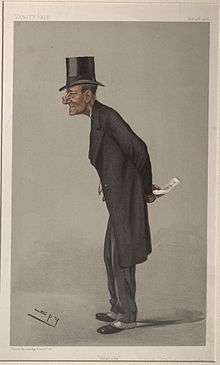Sir John Dillwyn-Llewellyn, 1st Baronet

As caricatured by Spy (Leslie Ward) in Vanity Fair, October 1900
Sir John Talbot Dillwyn-Llewellyn, 1st Baronet (26 May 1836 – 6 July 1927) was a Welsh Conservative Member of Parliament who was notable for his links to Welsh sports.
Background and education
Llewellyn was the son of photographer and scientist John Dillwyn Llewelyn and Emma Thomasina Talbot, youngest daughter of Thomas Mansel Talbot and Lady Mary (née Fox Strangways) of Penrice, south Wales and a cousin of William Henry Fox Talbot. He was educated at Eton and later Christ Church, Oxford.
Political career
Llewellyn was High Sheriff of Glamorgan in 1878 and Mayor of Swansea in 1891.
In 1889 he was elected as one of the first members of Glamorgan County Council and was immediately made an alderman, to which role he was re-elected in 1895. He was created a baronet, 'of Penllergaer in Llangyfelach and of Ynys-y-gerwn in Cadoxton juxta Neath both in the County of Glamorgan', on 20 March 1890.[1]
Llewelyn contested the Gower by-election of 1888 as a Conservative candidate. The Liberal ranks had been affected by divisions over the choice of candidate and Llewelyn polled well although narrowly defeated by David Randell.
In 1892, following the death of his uncle, Lewis Llewelyn Dillwyn, Llewelyn was adopted as Conservative candidate for the Swansea Town constituency but was defeated by R.D. Burnie. However he reversed the result three years later when he was elected Conservative MP for Swansea in the 1895 general election, but lost the seat in 1900.
Llewellyn's connections to sport included the position of captain of the South Wales Cricket Club and in 1885 he replaced the Earl of Jersey as the president of the Welsh Rugby Union; a post he would hold until 1906, when he was replaced by Horace Lyne. Lyne himself stated that 'they (WRU) had been singularly fortunate in getting a gentleman like Mr J.T.D. Llewellyn to act in that captaincy'.[2]
Family
Llewellyn married in 1861 Caroline Julia, daughter of Sir Michael Hicks Beach, 8th Baronet. Their younger and only surviving son Charles married the heiress of the Venables family and adopted the additional surname Venables. He became MP for Radnorshire and High Sheriff of that county.
Later life and death
Llewellyn died in 1927 aged 91 and was buried with his wife and next to his father in St David's Church in Pennllergare.
Legacy
Dillwyn Llewellyn Community School in Cockett, Swansea, was named for him – this was amalgamated with Dynevor School in 2001 to become Dylan Thomas Community School
See also
Bibliography
- Smith, David; Williams, Gareth (1980). Fields of Praise: The Official History of The Welsh Rugby Union. Cardiff: University of Wales Press. ISBN 0-7083-0766-3.
References
- ↑ The London Gazette: no. 26019. p. 545. 31 January 1890.
- ↑ Smith (1980), pg 48.
External links
- Hansard 1803–2005: contributions in Parliament by Sir John Dillwyn-Llewelyn
| Parliament of the United Kingdom | ||
|---|---|---|
| Preceded by Robert John Dickson Burnie |
Member of Parliament for Swansea Town 1895 – 1900 |
Succeeded by Sir George Newnes |
| Honorary titles | ||
| Preceded by |
High Sheriff of Glamorgan 1878-1879 |
Succeeded by |
| Baronetage of the United Kingdom | ||
| New creation | Baronet (of Penllergaer and Ynis-y-gerwn) 1890 – 1927 |
Succeeded by Charles Dillwyn-Venables-Llewellyn |